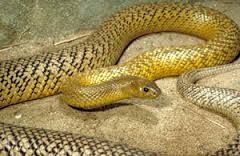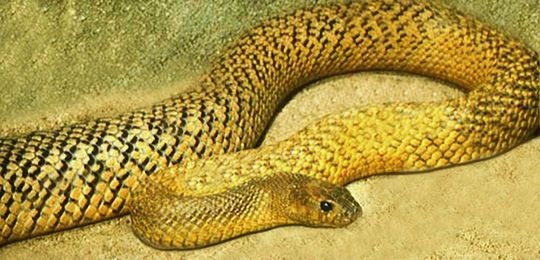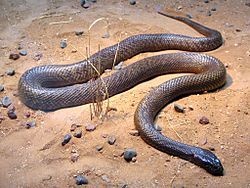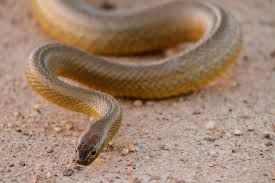Inland taipan Snake:
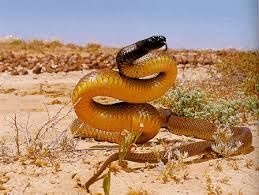
Introduction:
The inland taipan (Oxyuranus microlepidotus), also commonly known as the western taipan, the small-scaled snake, or the fierce snake, is an extremely venomous snake of the taipan (Oxyuranus) genus, and is endemic to semi-arid regions of central east Australia. Aboriginal Australians living in those regions named the snake Dandarabilla.It was first described by Frederick McCoyin 1879 and then by William John Macleay in 1882, but for the next 90 years, it was a mystery species to the scientific community. No more specimens were found, and virtually nothing was added to the knowledge of this species until its rediscovery in 1972.
The inland taipan is considered the most venomous snake in the world; based on the median lethal dose value in mice, its venom, drop for drop, is by far the most toxic of any snake – much more so than even sea snakes and it has the most toxic venom of any reptile when tested on human heart cell culture. Unlike most snakes, the inland taipan is a specialist mammal hunterso its venom is specially adapted to kill warm-blooded species.It is estimated that one bite possesses enough lethality to kill at least 100 full grown men, and, depending on the nature of the bite, it has the potential to kill someone in as little as 30 to 45 minutes if left untreated. It is an extremely fast and agile snake that can strike instantly with extreme accuracy,often striking multiple times in the same attack, and it envenoms in almost every case.
Scientific Name:
The inland taipan snake's scientific name is oxyuranus microlepidotus
Taxonomy:
The inland taipan first came to the attention of western science in 1879. Two specimens of the fierce snake were discovered in the junction of the Murray and Darling Rivers in northwestern Victoria and described by Frederick McCoy, who called the species Diemenia microlepidota, or small-scaled brown snake. In 1882 a third specimen was found near Bourke, New South Wales, and William John Macleay described the same snake under the name Diemenia ferox (thinking it was a different species).In 1896 George Albert Boulenger classified both as belonging to the same genus, Pseudechis (black snakes), referring them as Pseudechis microlepidotus and Pseudechis ferox.
In 1956, relying only on published descriptions and notes, James Roy Kinghorn regarded ferox as a synonym for microlepidotusand proposed the genus Parademansia. In 1963 Eric Worrell considered Parademansia microlepidotus and Oxyuranus scutellatus(coastal taipan, named simply "taipan" in those days) to be the same species. No more specimens were collected until 1972.
In 1967 a tour guide was bitten in far South West Queensland, and barely survived. What was thought to be at the time a western brown snake (Pseudonaja nuchalis) was, after its rediscovery in 1972, identified as an inland taipan.
In September 1972, after receiving an unclassified snake head sample from a grazier from one of the Channel Country stations west of Windorah of the far southwest Queensland, herpetologists Jeanette Covacevich (then working for the Queensland Museum) and Charles Tanner travelled to the site and found 13 living specimens, and rediscovered the lost snake Parademansia microlepidotus ,in 1976 Jeanette Covacevich and John Wombey argued that Parademansia microlepidotus belongs to a distinct genus, and this was also the opinion of Harold Cogger.
Covacevich, McDowell, Tanner & Mengden (1981) successfully argued, by comparing anatomical features, chromosomes and behaviour of the two species then known asOxyuranus scutellatus (taipan) and Parademansia microlepidota, that they belonged in a single genus. Oxyuranus (1923), the more senior name, was adopted for the combined genus.
Oxyuranus microlepidotus has been the fierce snake's binomial name since the early 1980s. The generic name, Oxyuranus, means oxus (Greek) "sharp pointed", oura(Greek) "tail"; -anus (Latin) "belonging to", and refers to the inland taipan's long pointed tail. The specific name, microlepidotus, means "small-scaled" (Latin). Hence the common name, small-scaled snake. Since it has been determined (Covacevich et al., 1981) that the fierce snake (formerly: Parademansia microlepidota) is actually part of the genusOxyuranus (taipan), another species, Oxyuranus scutellatus, which was previously commonly named taipan (coined from the aboriginal snake's name Dhayban) became coastal taipan (or eastern taipan), and the now newly classified Oxyuranus microlepidotus, became commonly known as inland taipan (or western taipan). The word "fierce" from its alternative name, fierce snake, describes its powerful venom.
Conservation status:
Like every Australian Snake the inland taipan is protected by law.
Private ownership law:
In Australia, it is legal to privately own an inland Taipan with the highest venomous class reptile license.
Seasonal adaptation:
Inland taipans adapt to their environment by changing the colour of the skin during seasonal changes. They tend to become lighter during summer and darker during the winter. This seasonal colour change serves the purpose of thermoregulation, allowing the snake to absorb more light in the colder months.
Diet and behaviour:
In the wild, the inland taipan consumes only mammals, mostly rodents, such as the long-haired rat (Rattus villosissimus), the plains rat (Pseudomys australis), the introduced house mouse (Mus musculus) and other dasyurids. Unlike other venomous snakes that strike with a single, accurate bite then retreat while waiting for the prey to die, the fierce snake subdues the prey with a series of rapid, accurate strikes. It is known to deliver up to eight venomous bites in a single attack, often snapping its jaws fiercely several times to inflict multiple punctures in the same attack. It's more risky attack strategy entails holding its prey with its body and biting it repeatedly. This injects the extremely toxic venom deep into the prey. The venom acts so rapidly that its prey does not have time to fight back.[In captivity it may also eat day-old chicks.
Reproduction:
Inland taipan produce clutches of between one and two dozen eggs. The eggs hatch two months later. The eggs are usually laid in abandoned animal burrows and deep crevices. Reproduction rate depends in part on their diet: if there is not enough food, then the snake will reproduce less.Captive snakes generally live for 10 to 15 years. An inland taipan at Australia Zoo lived to be over 20 years old.
Natural threats:
The king brown snake (Pseudechis australis) is immune to most Australian snake venom, and is known to also eat young inland taipans. The perentie (Varanus giganteus) is a large monitor lizard which also shares the same habitat. As it grows large enough, it will readily tackle large venomous snakes for prey.
Monitor Lizard:
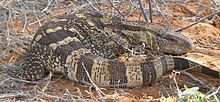
King Brown Snake:
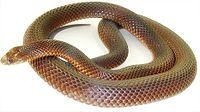
Interaction with humans:
Many reptile keepers consider it as a placid snake to work with. Inland taipans are rarely encountered in the wild by the average person because of their remoteness and brief above-ground appearance during the day. So long as a person is not creating much vibration and noise the inland taipan may not feel alarmed or bothered by a human presence. However, caution should be exercised and a safe distance maintained as it can inflict a potentially fatal bite. The inland taipan will defend itself and strike if provoked,mishandled or prevented from escaping. Firstly it makes a threat display by raising its forebody in a tight low S-shaped curve with its head facing the threat. Should the person choose to ignore the warning the inland taipan will strike. It is an extremely fast and agile snake which can strike instantly with extreme accuracy, and it envenoms in almost every case.
Inland taipan Snake Pictures:
